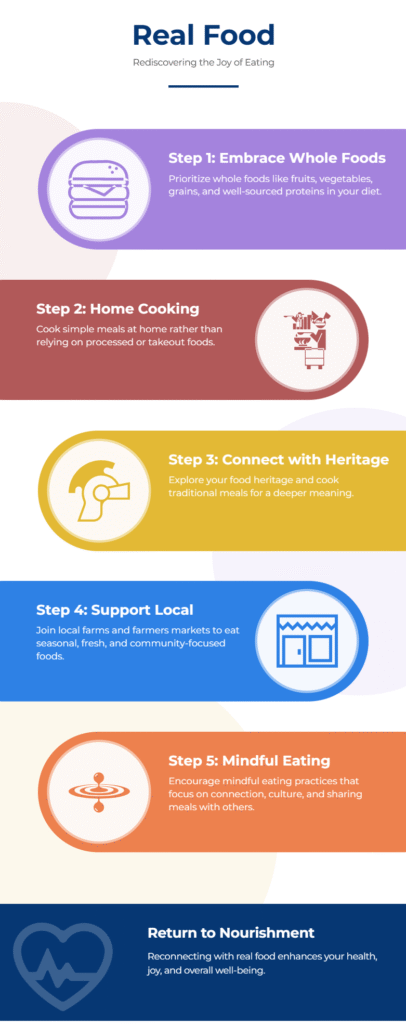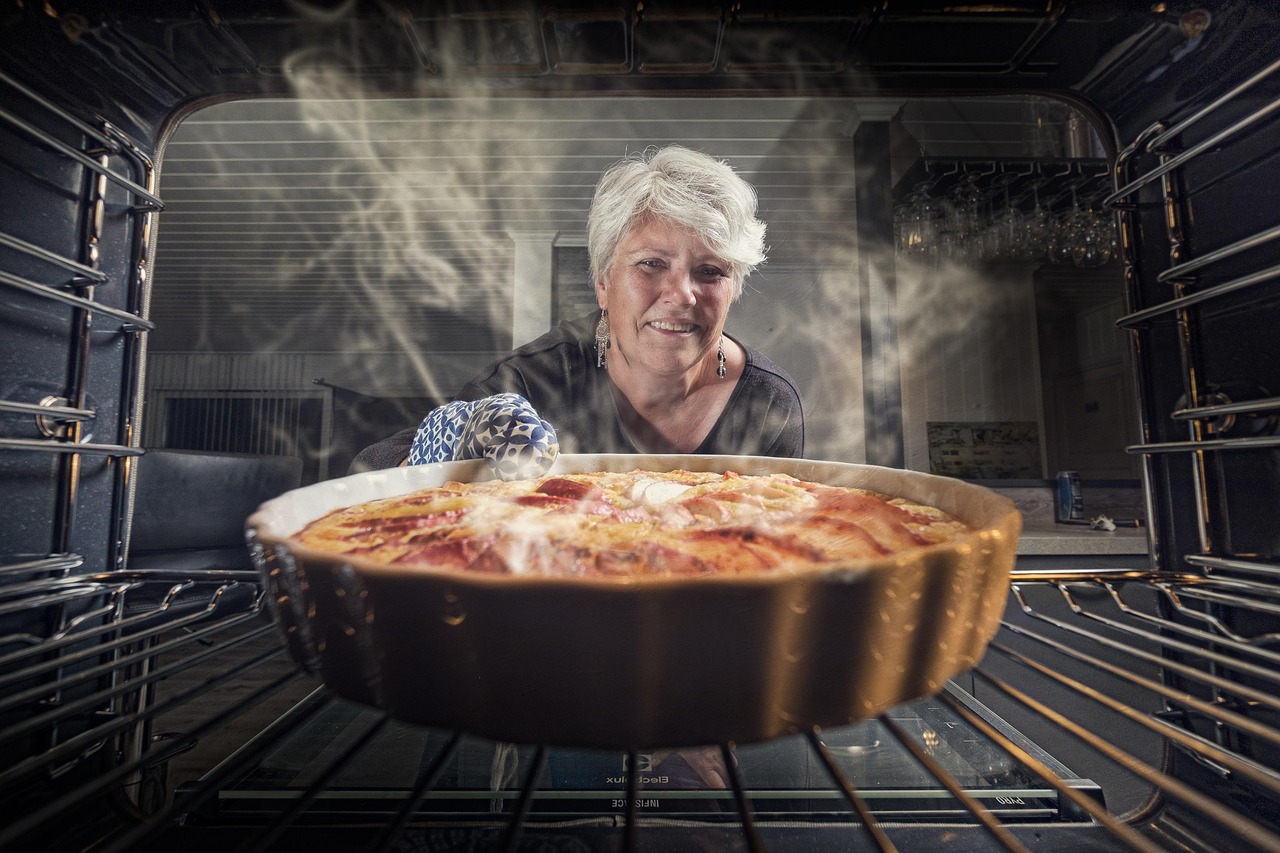Don’t miss a post. Click here to sign up for our free newsletter.
Estimated reading time: 7 minutes
Real Food
Do you ever find yourself standing in a grocery store aisle, staring at brightly colored packages, and wondering—what exactly is this stuff? If your grandmother wouldn’t recognize it as food, chances are, it’s not doing your body any favors.
In a world where convenience often trumps quality, we’ve strayed far from the nourishing, simple meals our grandparents used to make. The rise of ultra-processed foods, the decline in home cooking, and our collective addiction to sugar, salt, and fat have taken a toll on our health—and our connection to what we eat. But there’s good news: it’s not too late to turn back.
In this post, we’ll explore why eating like your grandparents might be the most powerful (and delicious) way to improve your health, reconnect with your roots, and rediscover the joy of food. And no, it doesn’t require becoming a full-time homesteader—just a few small shifts can make a world of difference.
The Wisdom of Simplicity
One of the most powerful pieces of advice I ever read came from author and food activist Michael Pollan:
“Don’t eat anything your great-grandmother wouldn’t recognize as food.”
This simple quote is both a wake-up call and a practical guideline. Let’s be honest—our ancestors didn’t eat protein bars, neon-colored cereal, or “cheese food.” They didn’t need ingredient lists because their food was the ingredient. A potato was a potato. A tomato was a tomato.
What does this mean for us today?
It means prioritizing whole foods—vegetables, fruits, grains, legumes, and well-sourced meat or fish. It means cooking more and relying less on the microwave. It means stepping away from the frozen food aisle and heading toward the produce section.
Pollan’s other mantra, “Eat food. Not too much. Mostly plants,” has become a modern classic because it cuts through the noise of dietary fads. It’s not about keto or paleo or vegan. It’s about reconnecting with real food and enjoying it in a way that supports health, not obsession.
Why Processed Food Hurts More Than It Helps
Let’s start with what we already know: ultra-processed food is bad for us. But let’s also understand why.
A 2019 study published in BMJ found that higher consumption of ultra-processed foods was associated with increased risks of cardiovascular disease, coronary heart disease, and cerebrovascular disorders. Another study in Cell Metabolism revealed that people who ate ultra-processed food consumed more calories and gained more weight, even when the meals were matched for nutrients and calories compared to unprocessed alternatives.
Here’s the problem: Ultra-processed foods are designed to bypass our natural satiety signals. They are engineered to taste “just right”—salty, sweet, fatty, crunchy—to keep us coming back for more. They digest quickly, spike our blood sugar, and leave us hungry again in no time.
Whole foods, on the other hand, are slow-burning, nourishing, and satisfying. They provide the nutrients our bodies actually need—fiber, antioxidants, phytonutrients, healthy fats, and protein—in a form that we evolved to thrive on.
Take Back the Kitchen: Make It Simple, Make It Yours
Cooking doesn’t have to be time-consuming or complicated. In fact, the most nourishing meals are often the simplest.
Instead of relying on takeout or processed snacks, try prepping a few healthy basics ahead of time:
- A big pot of vegetable soup or stew
- Roasted root vegetables and sautéed greens
- Hard-boiled eggs, hummus, or bean dip for protein-packed snacks
- Overnight oats or chia pudding for quick breakfasts
- A loaf of homemade sourdough or a simple buckwheat pancake mix
The trick is to keep your fridge stocked with easy, grab-and-go options that you’ve made yourself. Not only will this save you money and time—it’ll also help you avoid reaching for those nutrient-poor convenience foods when hunger strikes.
Want inspiration? Start by picking just two or three recipes from your childhood—or from a traditional cuisine you admire—and cook them this week. Think of it as an experiment in delicious nostalgia.
Rediscover Your Food Heritage
Our grandparents didn’t just eat differently—they lived differently. Food wasn’t just fuel. It was culture. It was celebration. It was connection.
By exploring your own food heritage or tapping into a traditional cuisine you’re drawn to, you’ll unlock a deeper sense of meaning around your meals. Whether it’s German sauerkraut, Japanese miso soup, Italian minestrone, or Mexican pozole, traditional foods are often rich in nutrients, fermented for gut health, and built around plant-based staples.
Try asking your parents or grandparents about the meals they grew up with. Better yet, cook those meals together. If you’ve lost that family connection, explore traditional cookbooks or YouTube tutorials from around the world. You’ll be surprised by how fun and fulfilling it can be to learn to cook with intention.
The Local Food Movement: Good for You, Good for the Planet
Another way to eat like your grandparents is to eat locally. Not just because it’s trendy, but because it makes sense.
Our ancestors often knew the farmer who raised their meat or grew their vegetables. Today, that connection is all but lost. But thanks to the rise of Community Supported Agriculture (CSA), farmers markets, and local food delivery subscriptions, we can get that connection back.
Here’s how to start:
- Join a local CSA to get weekly boxes of seasonal vegetables
- Visit a nearby farmer’s market and build relationships with growers
- Subscribe to a local greens box to encourage variety and reduce food waste
- Buy meat in bulk (like a quarter cow or half pig) from a local rancher
- Invest in a small freezer and learn how to store and use cuts you’re not familiar with
These steps may sound like a lot at first, but they create a rhythm that becomes second nature. You’ll discover vegetables you’ve never tried (what exactly is a kohlrabi?), and you’ll learn to use every part of the animal or plant, just like our grandparents did.
The payoff? Better nutrition, fewer chemicals, more flavor, stronger local economies, and a smaller environmental footprint.
Health, Longevity, and Joy
Let’s bring this full circle: why does any of this matter?
Because food is foundational to everything else. The quality of what you eat affects your energy, your mood, your sleep, your immune system, and your long-term health.
A growing body of research supports this. Studies on the Mediterranean diet, traditional Okinawan eating patterns, and Blue Zone communities (areas with the highest life expectancy) all point to the same principles:
- Whole, minimally processed foods
- Mostly plants
- Home-cooked meals
- Connection to culture and community
- Mindful eating, often shared with others
These are not complicated rules. They’re simple, elegant truths that have stood the test of time. And they offer a road map back to vitality—not through restriction or guilt, but through reconnection.
Final Thoughts: Make the Investment in Your Future Self
Eating like your grandparents isn’t about going backwards. It’s about taking timeless wisdom and applying it to our modern lives in a way that works for us.
It’s about making an investment—not just in your health, but in your happiness. In the joy of cooking. In the adventure of trying new foods. In the satisfaction of knowing where your food came from. In the delight of discovering that simple food can be deeply nourishing.
So here’s your challenge this week:
- Cook one traditional recipe from your family or a culture you admire.
- Find one local food source (a farmer, a CSA, a market).
- Prepare two healthy snacks to have on hand for the week.
- Start paying attention to what your food looks like—is it something your grandmother would recognize?
Small steps. Big impact.
Let’s Talk
Have you tried reconnecting with your food heritage? What traditional meals do you love? Do you have any tips for sourcing local food or cooking from scratch?
I’d love to hear your thoughts—drop a comment below or send me a message. Let’s keep this conversation going and learn from each other. After all, the table has always been a place of community.
Here’s to eating simply, living fully, and remembering where we came from.
Check out The Seven Pillars of Sustainable Health and Wellness, an introduction to our overall wellness coaching strategy.
Subscribe to our free newsletter to receive more health tips right in your inbox, or schedule a free 30-minute 1:1 call for a personal consultation.
Real Food | Cheat Sheet

